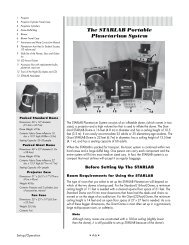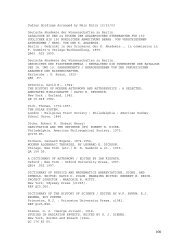K-6 Activities - Dudley Observatory
K-6 Activities - Dudley Observatory
K-6 Activities - Dudley Observatory
Create successful ePaper yourself
Turn your PDF publications into a flip-book with our unique Google optimized e-Paper software.
Materials<br />
• STARLAB Portable Planetarium<br />
• Projector<br />
• Starfield Cylinder<br />
K–6 <strong>Activities</strong> • B–74 •<br />
Stellar Position — Poles vs. Equator,<br />
Activity 6-5<br />
Objective<br />
The student should be able to demonstrate an understanding of the differences in stellar<br />
position at the equator versus the polar region.<br />
Procedure<br />
• Demonstrate the sky as seen from the North Pole. Tilt the projector to a latitude<br />
of 90° North. Locate the Big Dipper and Polaris. Turn on the daily motion switch<br />
and slowly rotate the cylinder in a complete circle. Show the students what stellar<br />
motion is like as viewed from the North Pole.<br />
• Show the sky as seen from the equator. Change the latitude of the cylinder to 0°<br />
or the equator. If the change is made slowly, the students will see familiar stars<br />
disappear to the north while new stars appear to the south. Turn on the daily motion<br />
to move the cylinder slowly in a complete circle. This will demonstrate stellar<br />
motion as seen from the equator. The North Star is due north on the horizon. The<br />
South Pole of the sky is due south on the horizon. The South Pole is hard to locate<br />
because no conspicuous stars mark it. Both points (the North and South Poles of<br />
the sky) will not appear to move.





